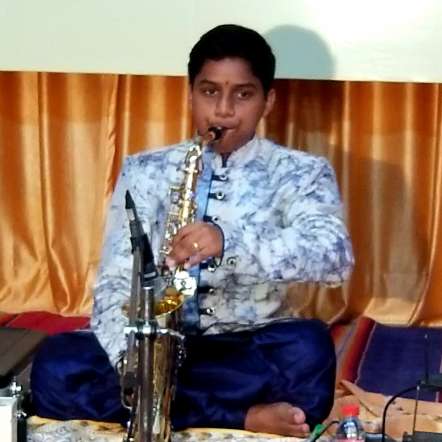
David Byrne Presents: A Taste of the Chennai Music Festival
By Todomundo
| Song | Artist | Purchase |
|---|---|---|
| Sri Mahaganapathe - Gowlai - Misrachapu | Neyveli Santhanagopalan & Muthuswami Dikshitar | Amazon |
| Mukundashtakam and Namasankeerthanam - Yamuna Kalyani - Khanta Chapu | Swetha Mohan | Amazon |
| Bhoot Mote - Chandrakouns - Ekam | Ranjani-Gayathri | Amazon |
| Rangapura Vihara - Brindavana Saranga - Rupakam | Ranjani-Gayathri | Amazon |
| Ragam Madhyamavati | U. Srinivas | Amazon |
| Vathapi Ganapathim - Hamsadhwani - Adi | Sumanth Swaminathan | Amazon |
| Andolika Varnam (Live) | Gokul | Amazon |
| Sri Kantimateem: Kriti | Chitravina N. Ravikiran, Mysore Manjunath & Guruvayoor Dorai | Amazon |
| Smaramyaham - Ramamanohari - Roopakam (Live) | Chitravina N. Ravikiran | Amazon |
| Annapoorne | U. Rajesh | Amazon |
| Partheeswari Jagat Janani | U. Rajesh, Dimitris Lambrianos & Praveen Narayan | Amazon |
| Vattapi Ganapathim - Hamasadwani - Adi | G. Ramanathan | Amazon |
| Mahaganapathim - Nattai - Chatuhsra Eka | J A Jayanth | iTunes |
| Siva Siva Bhava Bhava - Reeti Gowala - Aadi | Hyderabad Brothers | Amazon |
| Mathsya Avatar (Introduction) | Lalgudi G.J.R. Krishnan, Lalgudi Vijayalakshmi | Amazon |
| Mathsya Avatar | Lalgudi G.J.R. Krishnan, Lalgudi Vijayalakshmi | Amazon |
| Maha Ganapatim - Nata | T.N. Krishnan | Amazon |
| Tambura C# | Lalgudi G.J.R. Krishnan, Lalgudi Vijayalakshmi | Amazon |
| Meevalla | E. Gayathri | Amazon |
All photos by David Byrne.
After about a year of being on my own music tour I decided to stay in motion. Sometimes stopping cold turkey can be a bit of shock. So, in mid-December I flew to India and attended a few days of the Chennai Music Festival—also known as the December Season. It’s been going on every year for a long time; Yale from Luaka Bop and I poked in to catch part of a performance at least a decade ago when we were there working on the Vijaya Anand record.
The festival is mostly Carnatic (south Indian) music and it takes place in at least 10 small and medium size auditoriums all over town: some are on university campuses, some are part of religious organizations, some are in cultural institutions and some are even in tents. Most of the shows are free. Sometimes there is food and chai available between performances—very good food I might add. The daily schedule of shows starts around 9AM (when else would a morning raga be appropriate?) and the daily run ends around 9PM. Every day, all month. That’s a lot of music.
I didn’t manage to do 12 hours of music every day, but I did my best; one nice thing about performance in Asia is that audience members often come and go during the shows. They don’t chat, but there is an ebb and flow. Some shows were MUCH more popular than others. I could never figure out why, but then I am not an expert on this kind of music. I’d decide what to go to by looking at programs in the newspaper or an online newspaper and then I’d pick out some shows that seemed interesting to me. I wanted to see and hear the traditional performers, but I noticed there were quite a few in which performers were playing carnatic music on unexpected instruments. Here is a paper where I am trying to work out how to catch the maximum number of interesting (to me) performances in one day.
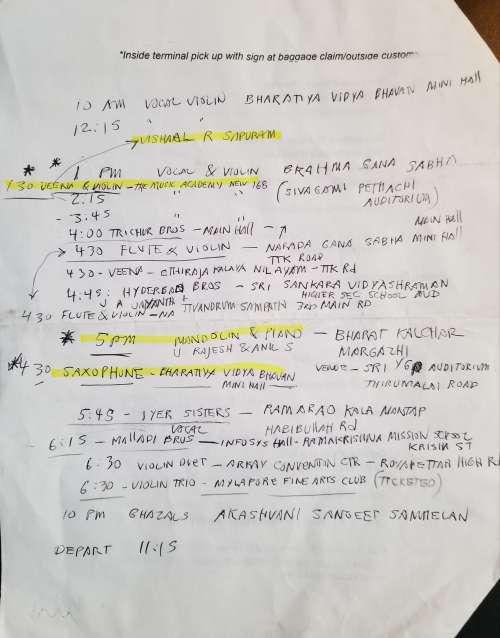
I used Uber cars or auto rickshaws to get me from one venue to the next. Ubers I used not for the comfort but because describing locations accurately with all the language issues (though English is spoken a little by a lot of folks in these big cities) sometimes became tricky. I was in Kochi on the west coast a few days before arriving in Chennai and there I had a bike to get around, but Chennai is much bigger and the traffic is crazy.
The music follows strict formats—the raga (scale), rhythm and mode are all predetermined, as well as the structure, but within those formats there is much improvisation. Some of the playing and singing is virtuosic and some have an aim to use their skills to add to the emotional poignancy of the melody. Most of the groups were made up of almost identical lineups: a tambora or two to provide the drone, often a violin or other melodic instrument to provide counter melodies to the vocalist or solist and some drums—most often a double headed mridangam drum and sometimes also a tabla player
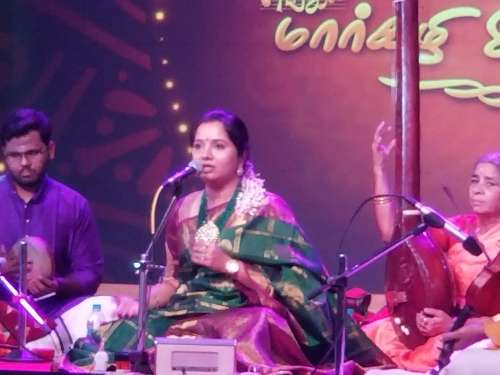
In the photo above the singer seems to have a little radio in front of her. I’m pretty sure it’s an electronic tanpura—an electronic version of the drone instrument. So she’s helping herself to stay on pitch by augmenting the drone provided by the real tanpura.
As anyone who checks out the accompanying playlist will notice, quite a few instrumentalists played what seemed to me, to be unexpected instruments—well, unexpected to me for this music.
A young man (he seemed to me to be in his teens) came on stage in a silver brocade jacket and played carnatic melodies that grooved in an unexpectedly funky way. (I have a different sax player on the playlist; there’s more than one!)

Young virtuosos were prized. Here is a VERY young girl playing a set on the veena—her instrument is larger than she is! She was pretty good! Well, to my untrained ears.
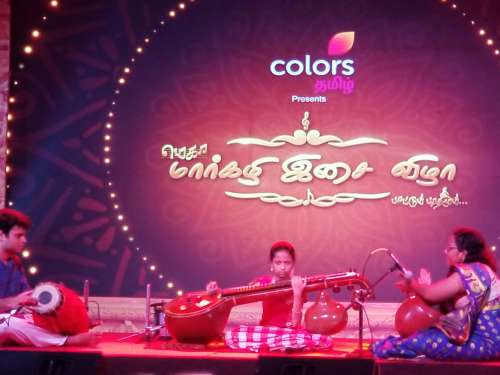
On another stage the soloist played a chitraveena (basically a veena played with a bottleneck)—carnatic Delta blues! Ry Cooder check this out. Very cool swoops growls and licks. I was blown away by this set.
Another night I caught a carnatic electric mandolin artiste…
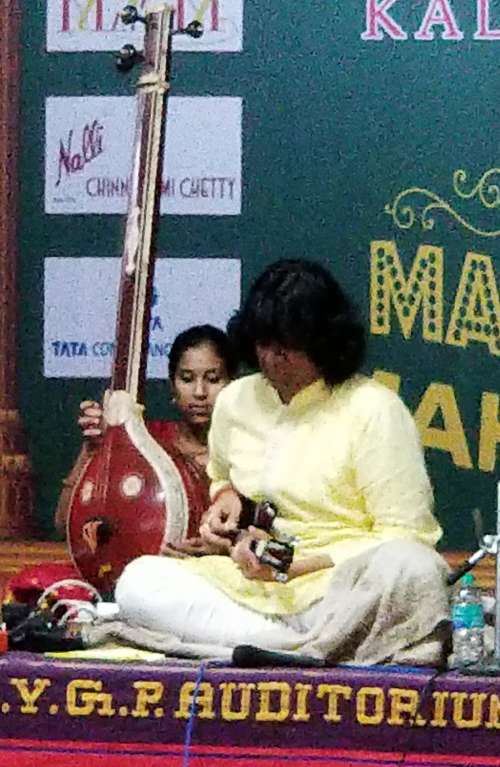
Srinivas was the most famous Carnatic mandolin player in India. The musician I saw plugged in and added some reverb and was accompanied by a pianist who took on the violinist role. It bordered on New Age music to my ears, but then sometimes it went somewhere completely psychedelic, which was a bit of a head twister. There’s an example on the playlist—you may not recognize it as a mandolin, but here is a short video:
I don’t think I ever dozed off, which might be a surprise, as we Westerners tend to associate much Indian music with meditation and a calm sense of spirituality. Although the songs often have spiritual themes, the vibe though not the actual music is more akin to jazz or flamenco—John Coltrane and Pharoah Sanders certainly saw their music as an expression of deep spirituality, but, like their music, Carnatic music is hardly soporific.
In my all too brief visit, I only touched the surface; the festival goes on for a whole month. I was tempted to buy one of these Carnatic players for deep immersion—a kind of digital boom box pre-loaded with 5,000 musical favorites.
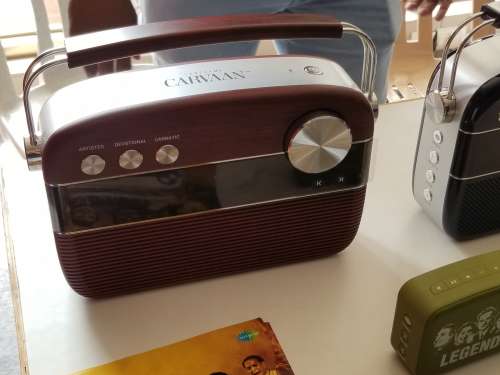
David Byrne
Read more about the Chennai Music Festival here.
David Byrne Presents: A Taste of the Chennai Music Festival
By Todomundo
| Song | Artist | Purchase |
|---|---|---|
| Sri Mahaganapathe - Gowlai - Misrachapu | Neyveli Santhanagopalan & Muthuswami Dikshitar | Amazon |
| Mukundashtakam and Namasankeerthanam - Yamuna Kalyani - Khanta Chapu | Swetha Mohan | Amazon |
| Bhoot Mote - Chandrakouns - Ekam | Ranjani-Gayathri | Amazon |
| Rangapura Vihara - Brindavana Saranga - Rupakam | Ranjani-Gayathri | Amazon |
| Ragam Madhyamavati | U. Srinivas | Amazon |
| Vathapi Ganapathim - Hamsadhwani - Adi | Sumanth Swaminathan | Amazon |
| Andolika Varnam (Live) | Gokul | Amazon |
| Sri Kantimateem: Kriti | Chitravina N. Ravikiran, Mysore Manjunath & Guruvayoor Dorai | Amazon |
| Smaramyaham - Ramamanohari - Roopakam (Live) | Chitravina N. Ravikiran | Amazon |
| Annapoorne | U. Rajesh | Amazon |
| Partheeswari Jagat Janani | U. Rajesh, Dimitris Lambrianos & Praveen Narayan | Amazon |
| Vattapi Ganapathim - Hamasadwani - Adi | G. Ramanathan | Amazon |
| Mahaganapathim - Nattai - Chatuhsra Eka | J A Jayanth | iTunes |
| Siva Siva Bhava Bhava - Reeti Gowala - Aadi | Hyderabad Brothers | Amazon |
| Mathsya Avatar (Introduction) | Lalgudi G.J.R. Krishnan, Lalgudi Vijayalakshmi | Amazon |
| Mathsya Avatar | Lalgudi G.J.R. Krishnan, Lalgudi Vijayalakshmi | Amazon |
| Maha Ganapatim - Nata | T.N. Krishnan | Amazon |
| Tambura C# | Lalgudi G.J.R. Krishnan, Lalgudi Vijayalakshmi | Amazon |
| Meevalla | E. Gayathri | Amazon |